How to Detect Scale Effect of Ecosystem Services Supply? A Comprehensive Insight from Xilinhot in Inner Mongolia, China
Abstract
1. Introduction
2. Materials and Methods
2.1. Study Area
2.2. Quantification of ES and Data Sources
2.3. Setting Space Scales of Multiple Levels
2.4. Data Analysis
3. Results
3.1. Spatial Distribution of Ecosystem Services Supply
3.2. Individual Ecosystem Service Patterns
3.2.1. Global Moran’s I
3.2.2. Anselin Local Moran’s I
3.3. Pairwise Ecosystem Services Interactions
3.3.1. Significance of Trade-Offs and Synergies
3.3.2. Strength of Trade-Offs and Synergies
3.4. Ecosystem Service Bundles
3.4.1. Multivariate Relationships
3.4.2. Spatially Explicit Bundles
4. Discussion
4.1. The Scale Effect of Ecosystem Services Supply
4.2. Uncertainties in Scaling-Up Process
4.3. A Framework for Integrating Patterns of Ecosystem Services and Associations among Them at Multiple Spatial Scales
5. Conclusions
Supplementary Materials
Author Contributions
Funding
Acknowledgments
Conflicts of Interest
References
- Millennium Ecosystem Assessment (MEA). Ecosystems and Human Well-being: Synthesis; Island Press: Washington, DC, USA, 2005; ISBN 978-159-726-711-3. [Google Scholar]
- Tallis, H.; Kareiva, P.; Marvier, M.; Chang, A. An ecosystem services framework to support both practical conservation and economic development. Proc. Natl. Acad. Sci. USA 2008. [Google Scholar] [CrossRef] [PubMed]
- Malinga, R.; Gordon, L.J.; Jewitt, G.; Lindborg, R. Mapping ecosystem services across scales and continents—A review. Ecosyst. Serv. 2015, 13, 57–63. [Google Scholar] [CrossRef]
- Costanza, R.; De Groot, R.; Braat, L.; Kubiszewski, I.; Fioramonti, L.; Sutton, P.; Farber, S.; Grasso, M. Twenty years of ecosystem services: How far have we come and how far do we still need to go? Ecosyst. Serv. 2017, 28, 1–16. [Google Scholar] [CrossRef]
- Spake, R.; Lasseur, R.; Crouzat, E.; Bullock, J.M.; Lavorel, S.; Parks, K.E.; Schaafsma, M.; Bennett, E.M.; Maes, J.; Mulligan, M.; et al. Unpacking ecosystem service bundles: Towards predictive mapping of synergies and trade-offs between ecosystem services. Glob. Environ. Chang. 2017, 47, 37–50. [Google Scholar] [CrossRef]
- Hauck, J.; Albert, C.; Fürst, C.; Geneletti, D.; La Rosa, D.; Lorz, C.; Spyra, M. Developing and applying ecosystem service indicators in decision-support at various scales. Ecol. Indic. 2016, 61, 1–5. [Google Scholar] [CrossRef]
- Jarvis, P.G. Scaling processes and problems. Plant Cell Environ. 1995, 18, 1079–1089. [Google Scholar] [CrossRef]
- Rivera, J.M.; Muñoz, M.J.; Moneva, J.M. Revisiting the Relationship Between Corporate Stakeholder Commitment and Social and Financial Performance. Sustain. Dev. 2017, 25, 482–494. [Google Scholar] [CrossRef]
- Syrbe, R.U.; Walz, U. Spatial indicators for the assessment of ecosystem services: Providing, benefiting and connecting areas and landscape metrics. Ecol. Indic. 2012, 21, 80–88. [Google Scholar] [CrossRef]
- Burkhard, B.; Kroll, F.; Nedkov, S.; Müller, F. Mapping ecosystem service supply, demand and budgets. Ecol. Indic. 2012, 21, 17–29. [Google Scholar] [CrossRef]
- García-Nieto, A.P.; García-Llorente, M.; Iniesta-Arandia, I.; Martín-López, B. Mapping forest ecosystem services: From providing units to beneficiaries. Ecosyst. Serv. 2013, 4, 126–138. [Google Scholar] [CrossRef]
- Boithias, L.; Acuña, V.; Vergoñós, L.; Ziv, G.; Marcé, R.; Sabater, S. Assessment of the water supply: Demand ratios in a Mediterranean basin under different global change scenarios and mitigation alternatives. Sci. Total Environ. 2014, 470–471, 567–577. [Google Scholar] [CrossRef] [PubMed]
- Wolff, S.; Schulp, C.J.E.; Verburg, P.H. Mapping ecosystem services demand: A review of current research and future perspectives. Ecol. Indic. 2015, 55, 159–171. [Google Scholar] [CrossRef]
- Luck, G.W.; Daily, G.C.; Ehrlich, P.R. Population diversity and ecosystem services. Trends Ecol. Evol. 2003, 18, 331–336. [Google Scholar] [CrossRef]
- Zheng, H.; Robinson, B.E.; Liang, Y.-C.; Polasky, S.; Ma, D.-C.; Wang, F.-C.; Ruckelshaus, M.; Ouyang, Z.-Y.; Daily, G.C. Benefits, costs, and livelihood implications of a regional payment for ecosystem service program. Proc. Natl. Acad. Sci. USA 2013, 110, 16681–16686. [Google Scholar] [CrossRef] [PubMed]
- Rozas-Vásquez, D.; Fürst, C.; Geneletti, D.; Almendra, O. Integration of ecosystem services in strategic environmental assessment across spatial planning scales. Land Use Policy 2018, 71, 303–310. [Google Scholar] [CrossRef]
- Lin, Y.P.; Lin, W.C.; Wang, Y.C.; Lien, W.Y.; Huang, T.; Hsu, C.C.; Schmeller, D.S.; Crossman, N.D. Systematically designating conservation areas for protecting habitat quality and multiple ecosystem services. Environ. Model. Softw. 2017, 90, 126–146. [Google Scholar] [CrossRef]
- Wang, B.; Tang, H.; Xu, Y. Integrating ecosystem services and human well-being into management practices: Insights from a mountain-basin area, China. Ecosyst. Serv. 2017, 27, 58–69. [Google Scholar] [CrossRef]
- Fu, B.; Liu, Y.; Lü, Y.; He, C.; Zeng, Y.; Wu, B. Assessing the soil erosion control service of ecosystems change in the Loess Plateau of China. Ecol. Complex. 2011, 8, 284–293. [Google Scholar] [CrossRef]
- Yang, G.; Ge, Y.; Xue, H.; Yang, W.; Shi, Y.; Peng, C.; Du, Y.; Fan, X.; Ren, Y.; Chang, J. Using ecosystem service bundles to detect trade-offs and synergies across urban-rural complexes. Landsc. Urban Plan. 2015, 136, 110–121. [Google Scholar] [CrossRef]
- Kong, L.; Zheng, H.; Xiao, Y.; Ouyang, Z.; Li, C.; Zhang, J.; Huang, B. Mapping ecosystem service bundles to detect distinct types of multifunctionality within the diverse landscape of the Yangtze River Basin, China. Sustainability 2018, 10, 857. [Google Scholar] [CrossRef]
- Rabe, S.E.; Koellner, T.; Marzelli, S.; Schumacher, P.; Grêt-Regamey, A. National ecosystem services mapping at multiple scales—The German exemplar. Ecol. Indic. 2016, 70, 357–372. [Google Scholar] [CrossRef]
- Redhead, J.W.; May, L.; Oliver, T.H.; Hamel, P.; Sharp, R.; Bullock, J.M. National scale evaluation of the InVEST nutrient retention model in the United Kingdom. Sci. Total Environ. 2018, 610, 666–677. [Google Scholar] [CrossRef] [PubMed]
- Petz, K.; Alkemade, R.; Bakkenes, M.; Schulp, C.J.E.; van der Velde, M.; Leemans, R. Mapping and modelling trade-offs and synergies between grazing intensity and ecosystem services in rangelands using global-scale datasets and models. Glob. Environ. Chang. 2014, 29, 223–234. [Google Scholar] [CrossRef]
- Bennett, E.M.; Peterson, G.D.; Gordon, L.J. Understanding relationships among multiple ecosystem services. Ecol. Lett. 2009, 12, 1394–1404. [Google Scholar] [CrossRef] [PubMed]
- Howe, C.; Suich, H.; Vira, B.; Mace, G.M. Creating win-wins from trade-offs? Ecosystem services for human well-being: A meta-analysis of ecosystem service trade-offs and synergies in the real world. Glob. Environ. Chang. 2014, 28, 263–275. [Google Scholar] [CrossRef]
- Rodríguez, J.P.; Beard, T.D.; Bennett, E.M.; Cumming, G.S.; Cork, S.J.; Agard, J.; Dobson, A.P.; Peterson, G.D. Trade-offs across space, time, and ecosystem services. Ecol. Soc. 2006, 11. [Google Scholar] [CrossRef]
- Raudsepp-Hearne, C.; Peterson, G.D.; Bennett, E.M. Ecosystem service bundles for analyzing tradeoffs in diverse landscapes. Proc. Natl. Acad. Sci. USA 2010, 107, 5242–5247. [Google Scholar] [CrossRef] [PubMed]
- Haase, D.; Schwarz, N.; Strohbach, M.; Kroll, F.; Seppelt, R. Synergies, trade-offs, and losses of ecosystem services in urban regions: An integrated multiscale framework applied to the Leipzig-Halle region, Germany. Ecol. Soc. 2012, 17. [Google Scholar] [CrossRef]
- Turner, K.G.; Odgaard, M.V.; Bøcher, P.K.; Dalgaard, T.; Svenning, J.C. Bundling ecosystem services in Denmark: Trade-offs and synergies in a cultural landscape. Landsc. Urban Plan. 2014, 125, 89–104. [Google Scholar] [CrossRef]
- Sun, X.; Li, F.; Sun, X.; Li, F. Spatiotemporal assessment and trade-offs of multiple ecosystem services based on land use changes in Zengcheng, China. Sci. Total Environ. 2017, 609, 1569–1581. [Google Scholar] [CrossRef] [PubMed]
- Qin, K.; Li, J.; Yang, X. Trade-off and synergy among ecosystem services in the Guanzhong-Tianshui economic region of China. Int. J. Environ. Res. Public Health 2015, 12, 14094–14113. [Google Scholar] [CrossRef] [PubMed]
- Kang, H.; Seely, B.; Wang, G.; Innes, J.; Zheng, D.; Chen, P.; Wang, T.; Li, Q. Evaluating management tradeoffs between economic fiber production and other ecosystem services in a Chinese-fir dominated forest plantation in Fujian Province. Sci. Total Environ. 2016, 557–558, 80–90. [Google Scholar] [CrossRef] [PubMed]
- Mouchet, M.A.; Paracchini, M.L.; Schulp, C.J.E.; Stürck, J.; Verkerk, P.J.; Verburg, P.H.; Lavorel, S. Bundles of ecosystem (dis)services and multifunctionality across European landscapes. Ecol. Indic. 2017, 73, 23–28. [Google Scholar] [CrossRef]
- Raudsepp-Hearne, C.; Peterson, G.D. Scale and ecosystem services: How do observation, management, and analysis shift with scale—lessons from Québec. Ecol. Soc. 2016, 21. [Google Scholar] [CrossRef]
- Holland, R.A.; Eigenbrod, F.; Armsworth, P.R.; Anderson, B.J.; Thomas, C.D.; Heinemeyer, A.; Gillings, S.; Roy, D.B.; Gaston, K.J. Spatial covariation between freshwater and terrestrial ecosystem services. Ecol. Appl. 2011, 21, 2034–2048. [Google Scholar] [CrossRef] [PubMed]
- Comín, F.A.; Miranda, B.; Sorando, R.; Felipe-Lucia, M.R.; Jiménez, J.J.; Navarro, E. Prioritizing sites for ecological restoration based on ecosystem services. J. Appl. Ecol. 2018, 55, 1155–1163. [Google Scholar] [CrossRef]
- Liu, Y.; Bi, J.; Lv, J.; Ma, Z.; Wang, C. Spatial multi-scale relationships of ecosystem services: A case study using a geostatistical methodology. Sci. Rep. 2017, 7. [Google Scholar] [CrossRef] [PubMed]
- Xu, S.; Liu, Y.; Wang, X.; Zhang, G. Scale effect on spatial patterns of ecosystem services and associations among them in semi-arid area: A case study in Ningxia Hui Autonomous Region, China. Sci. Total Environ. 2017, 598, 297–306. [Google Scholar] [CrossRef] [PubMed]
- Goldstein, J.H.; Caldarone, G.; Duarte, T.K.; Ennaanay, D.; Hannahs, N.; Mendoza, G.; Polasky, S.; Wolny, S.; Daily, G.C. Integrating ecosystem-service tradeoffs into land-use decisions. Proc. Natl. Acad. Sci. USA 2012, 109, 7565–7570. [Google Scholar] [CrossRef] [PubMed]
- Hao, R.; Yu, D.; Liu, Y.; Liu, Y.; Qiao, J.; Wang, X.; Du, J. Impacts of changes in climate and landscape pattern on ecosystem services. Sci. Total Environ. 2017, 579, 718–728. [Google Scholar] [CrossRef] [PubMed]
- Du, H.; Dou, S.; Deng, X.; Xue, X.; Wang, T. Assessment of wind and water erosion risk in the watershed of the Ningxia-Inner Mongolia Reach of the Yellow River, China. Ecol. Indic. 2016, 67, 117–131. [Google Scholar] [CrossRef]
- Shi, Z.H.; Ai, L.; Fang, N.F.; Zhu, H.D. Modeling the impacts of integrated small watershed management on soil erosion and sediment delivery: A case study in the Three Gorges Area, China. J. Hydrol. 2012, 438–439, 156–167. [Google Scholar] [CrossRef]
- About ArcGIS | Mapping & Analytics Platform. Available online: https://www.esri.com/en-us/arcgis/about-arcgis/overview (accessed on 13 September 2018).
- Yang, W.; Dietz, T.; Liu, W.; Luo, J.; Liu, J. Going Beyond the Millennium Ecosystem Assessment: An Index System of Human Dependence on Ecosystem Services. PLoS ONE 2013, 8. [Google Scholar] [CrossRef] [PubMed]
- R: The R Project for Statistical Computing. Available online: https://www.r-project.org/ (accessed on 13 September 2018).
- Abson, D.J.; Dougill, A.J.; Stringer, L.C. Using Principal Component Analysis for information-rich socio-ecological vulnerability mapping in Southern Africa. Appl. Geogr. 2012, 35, 515–524. [Google Scholar] [CrossRef]
- Marsboom, C.; Vrebos, D.; Staes, J.; Meire, P. Using dimension reduction PCA to identify ecosystem service bundles. Ecol. Indic. 2018, 87, 209–260. [Google Scholar] [CrossRef]
- Kohonen, T. Self-organized formation of topologically correct feature maps. Biol. Cybern. 1982, 43, 59–69. [Google Scholar] [CrossRef]
- Andreini, E.; Finzel, J.; Rao, D.; Larson-Praplan, S.; Oltjen, J.W. Estimation of the Requirement for Water and Ecosystem Benefits of Cow-Calf Production on California Rangeland. Rangelands 2018, 40, 24–31. [Google Scholar] [CrossRef]
- Hein, L.; Van Koppen, K.; De Groot, R.S.; Van Ierland, E.C. Spatial scales, stakeholders and the valuation of ecosystem services. Ecol. Econ. 2006, 57, 209–228. [Google Scholar] [CrossRef]
- Kareiva, P.; Watts, S.; McDonald, R.; Boucher, T. Domesticated nature: Shaping landscapes and ecosystems for human welfare. Science 2007, 316, 1866–1869. [Google Scholar] [CrossRef] [PubMed]
- Yong-Zhong, S.; Yu-Lin, L.; Jian-Yuan, C.; Wen-Zhi, Z. Influences of continuous grazing and livestock exclusion on soil properties in a degraded sandy grassland, Inner Mongolia, northern China. Catena 2005, 59, 267–278. [Google Scholar] [CrossRef]
- Wang, Z.J.; Jiao, J.Y.; Rayburg, S.; Wang, Q.L.; Su, Y. Soil erosion resistance of “Grain for Green” vegetation types under extreme rainfall conditions on the Loess Plateau, China. Catena 2016, 141, 109–116. [Google Scholar] [CrossRef]
- Huang, Z.; Liu, Y.; Cui, Z.; Fang, Y.; He, H.; Liu, B.R.; Wu, G.L. Soil water storage deficit of alfalfa (Medicago sativa) grasslands along ages in arid area (China). Field Crops Res. 2018, 221, 1–6. [Google Scholar] [CrossRef]
- Hou, Y.; Lü, Y.; Chen, W.; Fu, B. Temporal variation and spatial scale dependency of ecosystem service interactions: A case study on the central Loess Plateau of China. Landsc. Ecol. 2017, 32, 1201–1217. [Google Scholar] [CrossRef]
- Burkhard, B.; Maes, J. Mapping Ecosystem Services; Burkhard, B., Maes, J., Eds.; Pensoft Publishers: Sofia, Bulgaria, 2017; Volume 1, ISBN 978-954-642-830-1. [Google Scholar]
- Lv, J.; Liu, Y.; Zhang, Z.; Dai, J. Factorial kriging and stepwise regression approach to identify environmental factors influencing spatial multi-scale variability of heavy metals in soils. J. Hazard Mater. 2013, 261, 387–397. [Google Scholar] [CrossRef] [PubMed]
- Felipe-Lucia, M.R.; Comín, F.A.; Bennett, E.M. Interactions among ecosystem services across land uses in a floodplain agroecosystem. Ecol. Soc. 2014, 19. [Google Scholar] [CrossRef]
- Posner, S.; Getz, C.; Ricketts, T. Evaluating the impact of ecosystem service assessments on decision-makers. Environ. Sci. Policy 2016, 64, 30–37. [Google Scholar] [CrossRef]
- Lin, Y.-P.; Lin, W.-C.; Li, H.-Y.; Wang, Y.-C.; Hsu, C.-C.; Lien, W.-Y.; Anthony, J.; Petway, J.R. Integrating Social Values and Ecosystem Services in Systematic Conservation Planning: A Case Study in Datuan Watershed. Sustainability 2017, 9, 718. [Google Scholar] [CrossRef]
- Schröter, M.; Remme, R.P. Spatial prioritisation for conserving ecosystem services: Comparing hotspots with heuristic optimisation. Landsc. Ecol. 2016, 31, 431–450. [Google Scholar] [CrossRef] [PubMed]
- Bradford, J.B.; D’Amato, A.W. Recognizing trade-offs in multi-objective land management. Front. Ecol. Environ. 2012, 10, 210–216. [Google Scholar] [CrossRef]
- Lu, N.; Fu, B.; Jin, T.; Chang, R. Trade-off analyses of multiple ecosystem services by plantations along a precipitation gradient across Loess Plateau landscapes. Landsc. Ecol. 2014, 29, 1697–1708. [Google Scholar] [CrossRef]
- Ruijs, A.; Wossink, A.; Kortelainen, M.; Alkemade, R.; Schulp, C.J.E. Trade-off analysis of ecosystem services in Eastern Europe. Ecosyst. Serv. 2013, 4, 82–94. [Google Scholar] [CrossRef]
- Satake, A.; Rudel, T.K.; Onuma, A. Scale mismatches and their ecological and economic effects on landscapes: A spatially explicit model. Glob. Environ. Chang. 2008, 18, 768–775. [Google Scholar] [CrossRef]
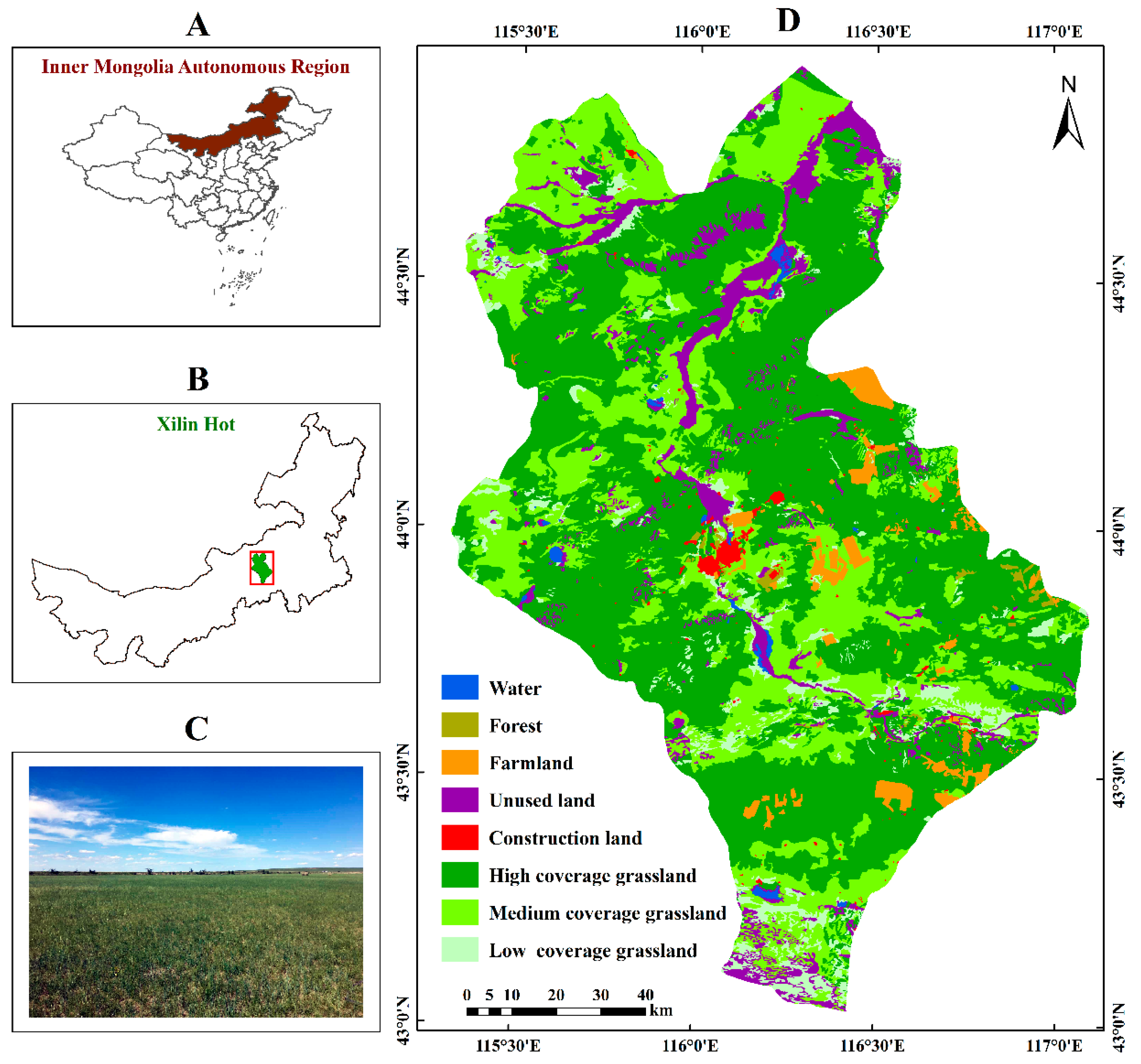
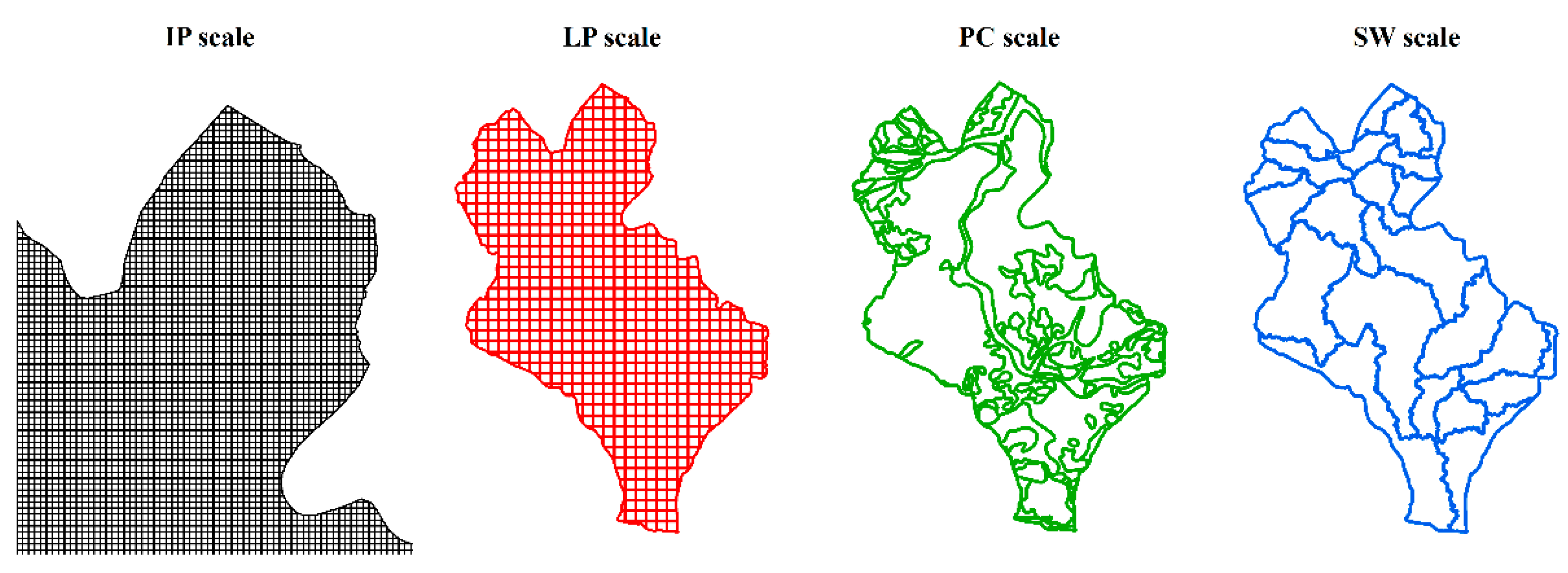
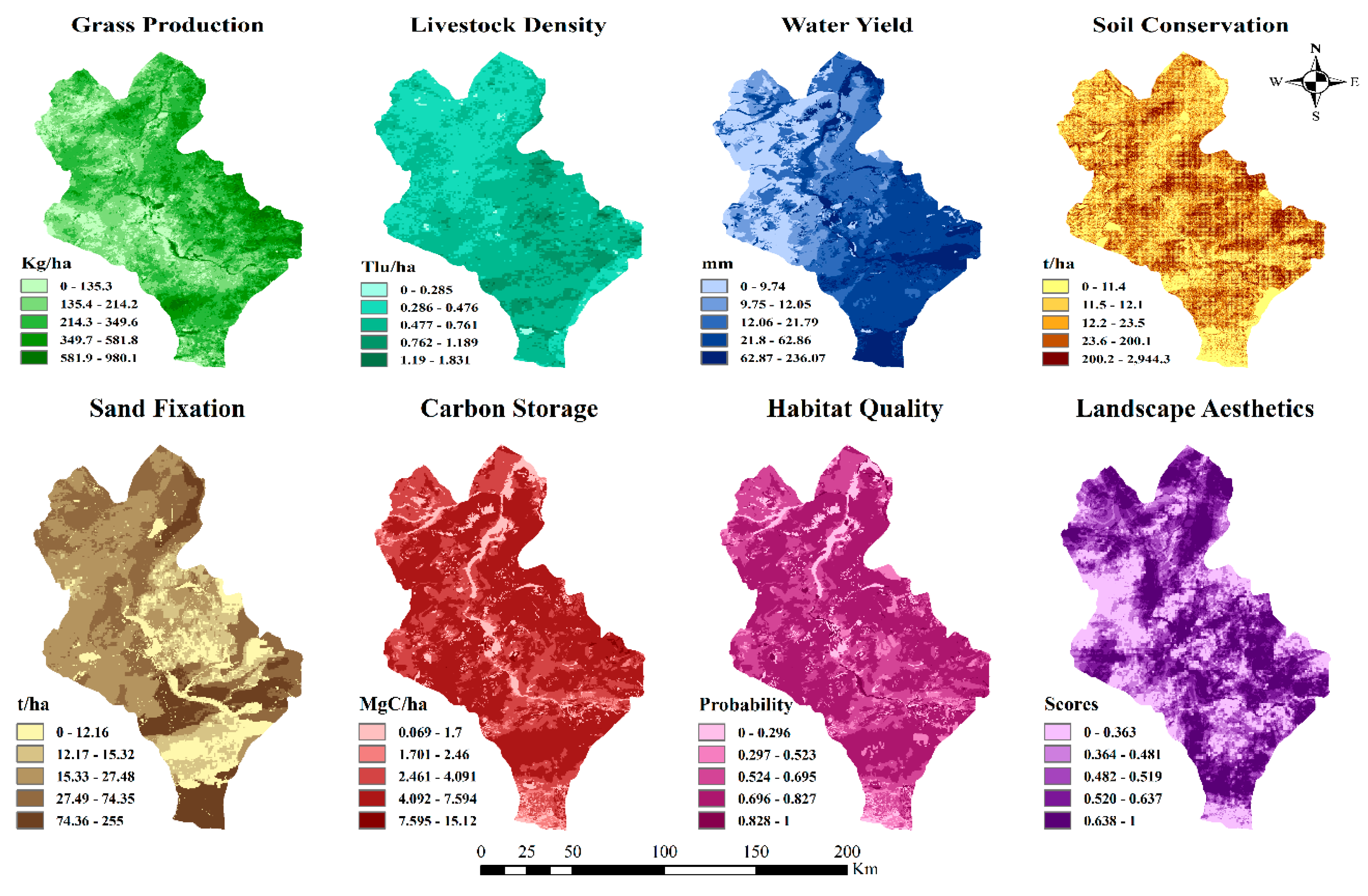
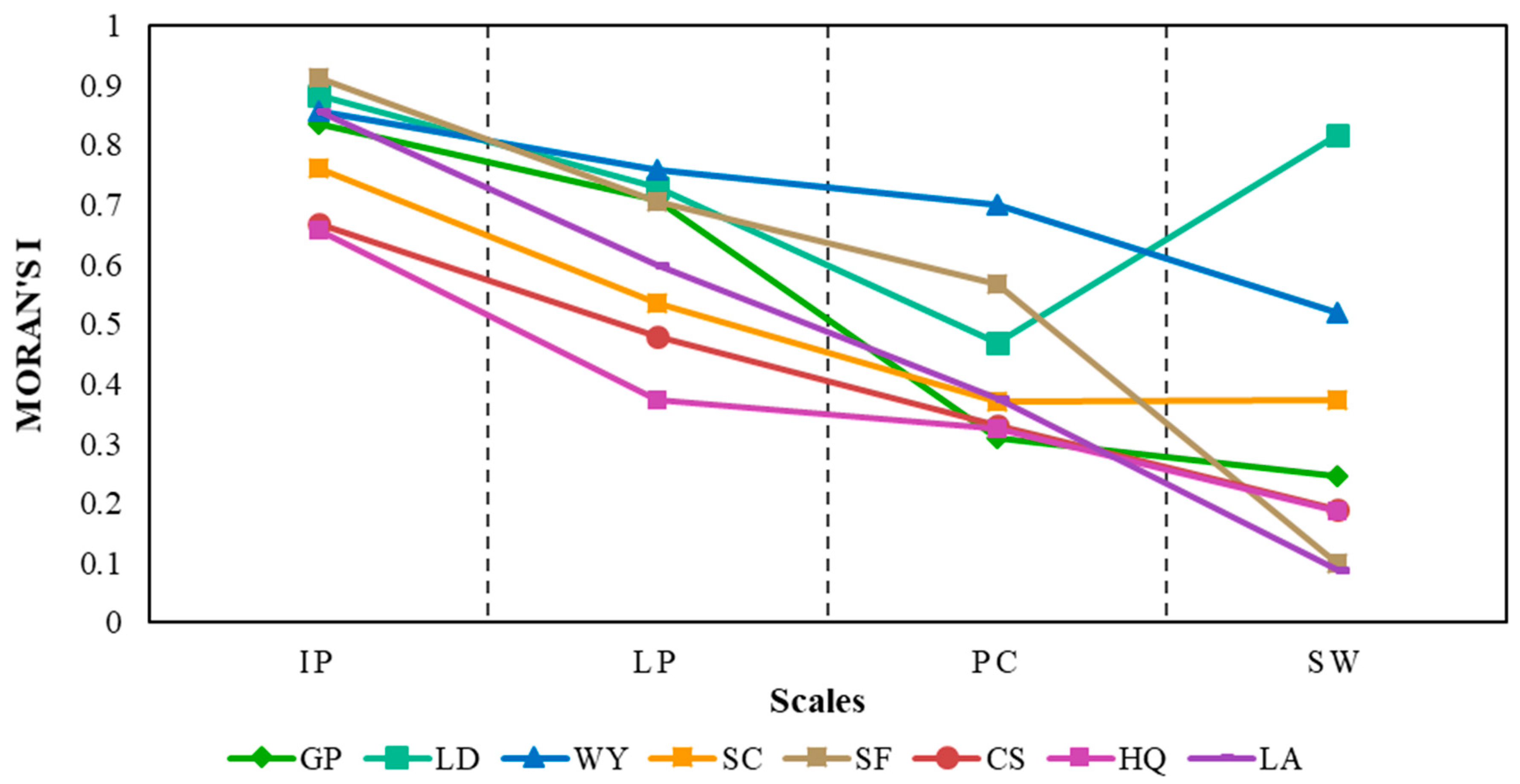
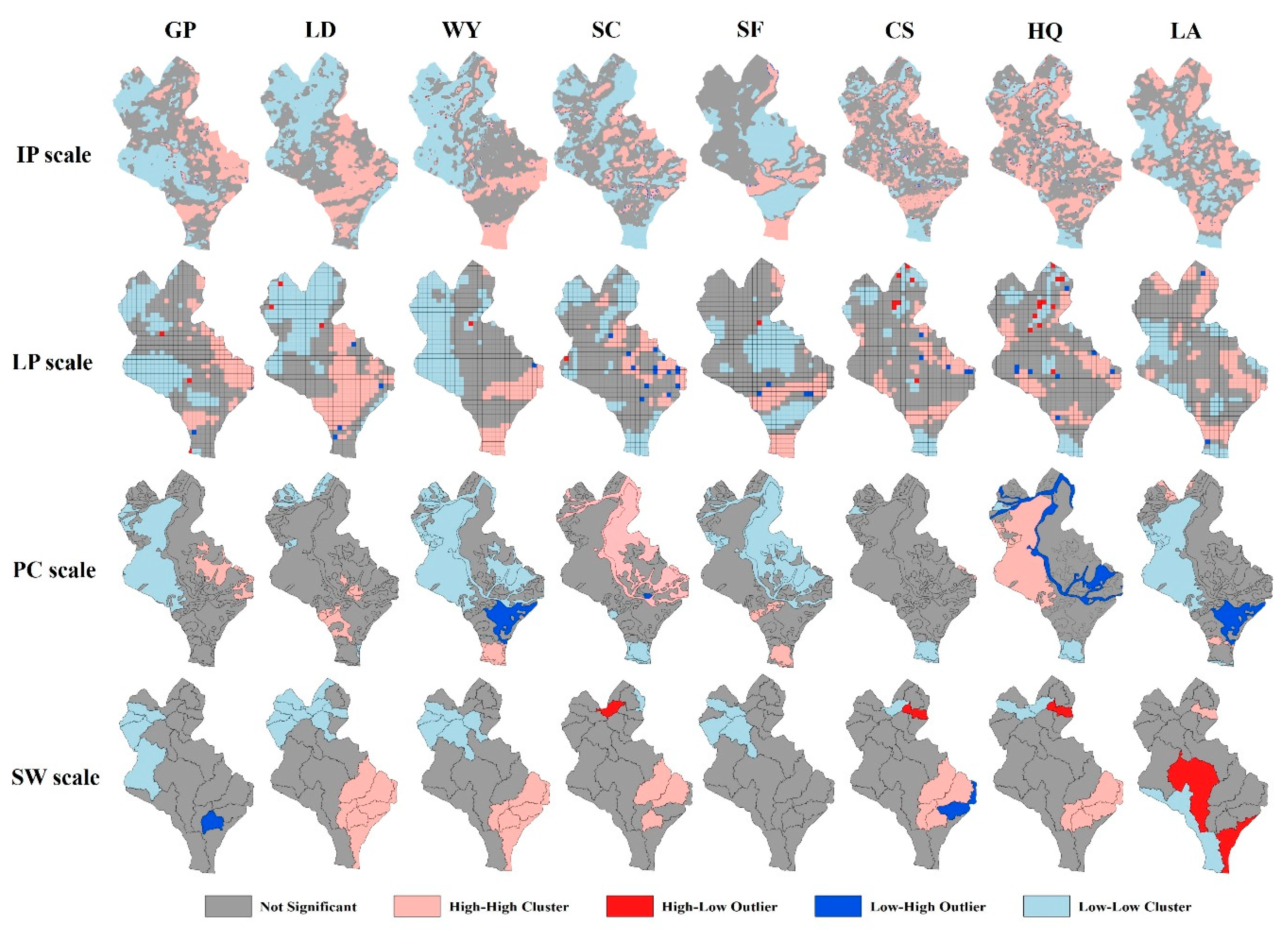

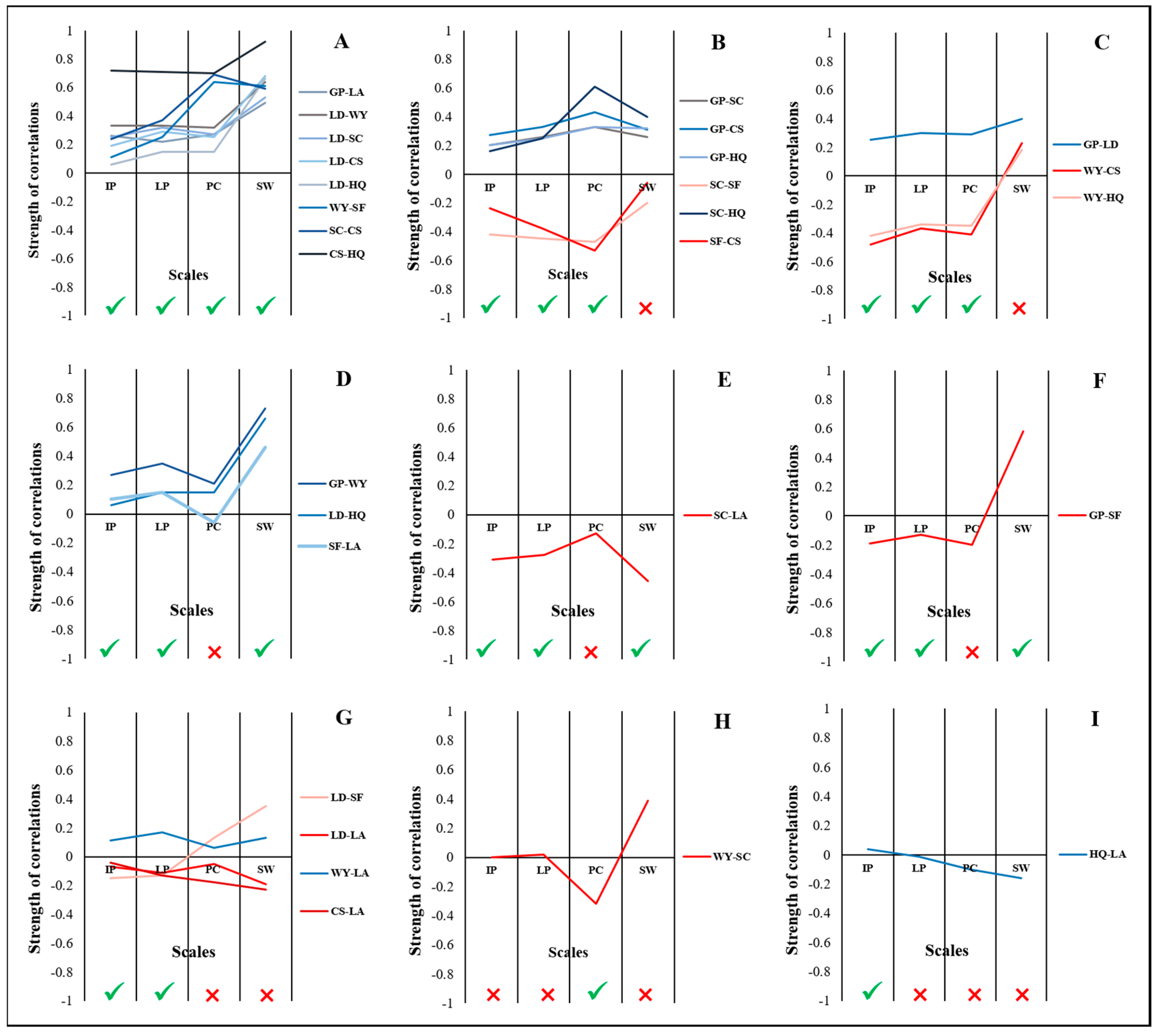

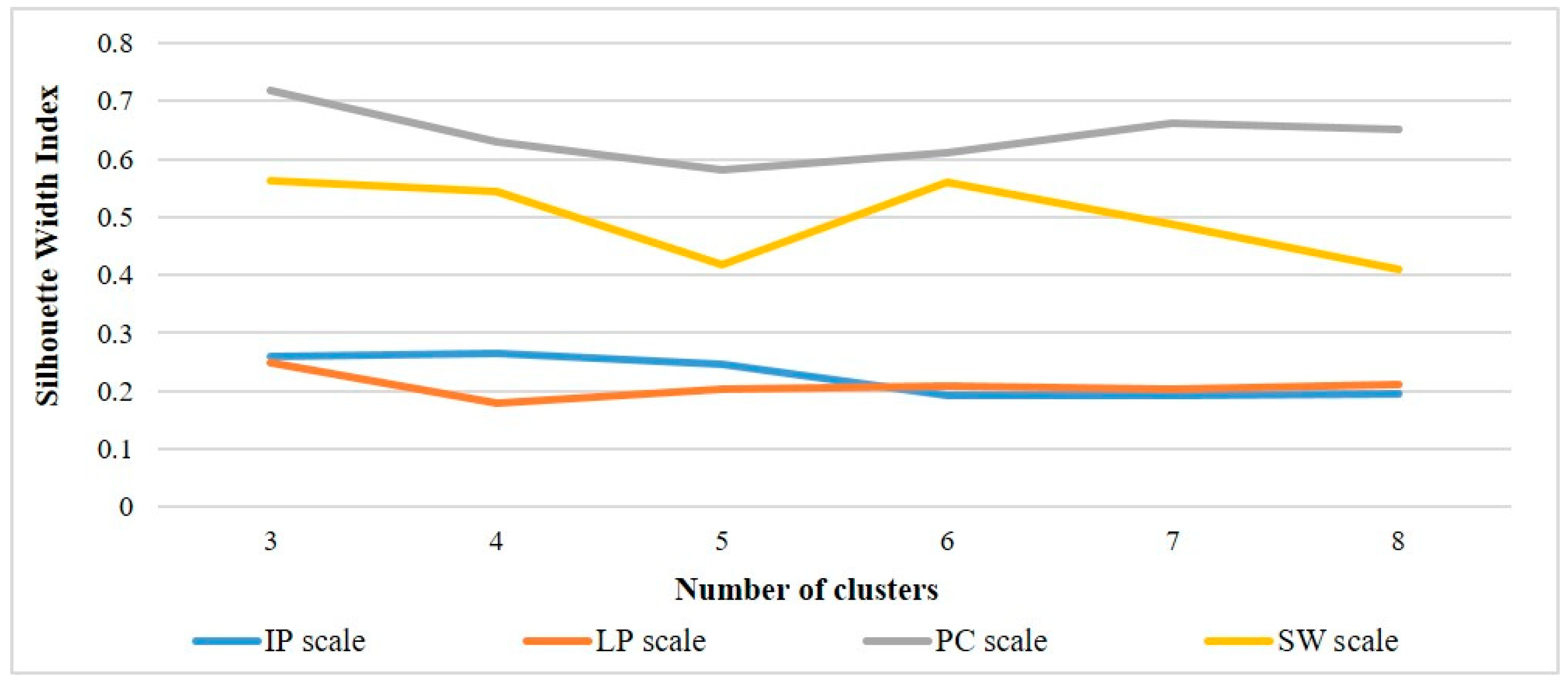
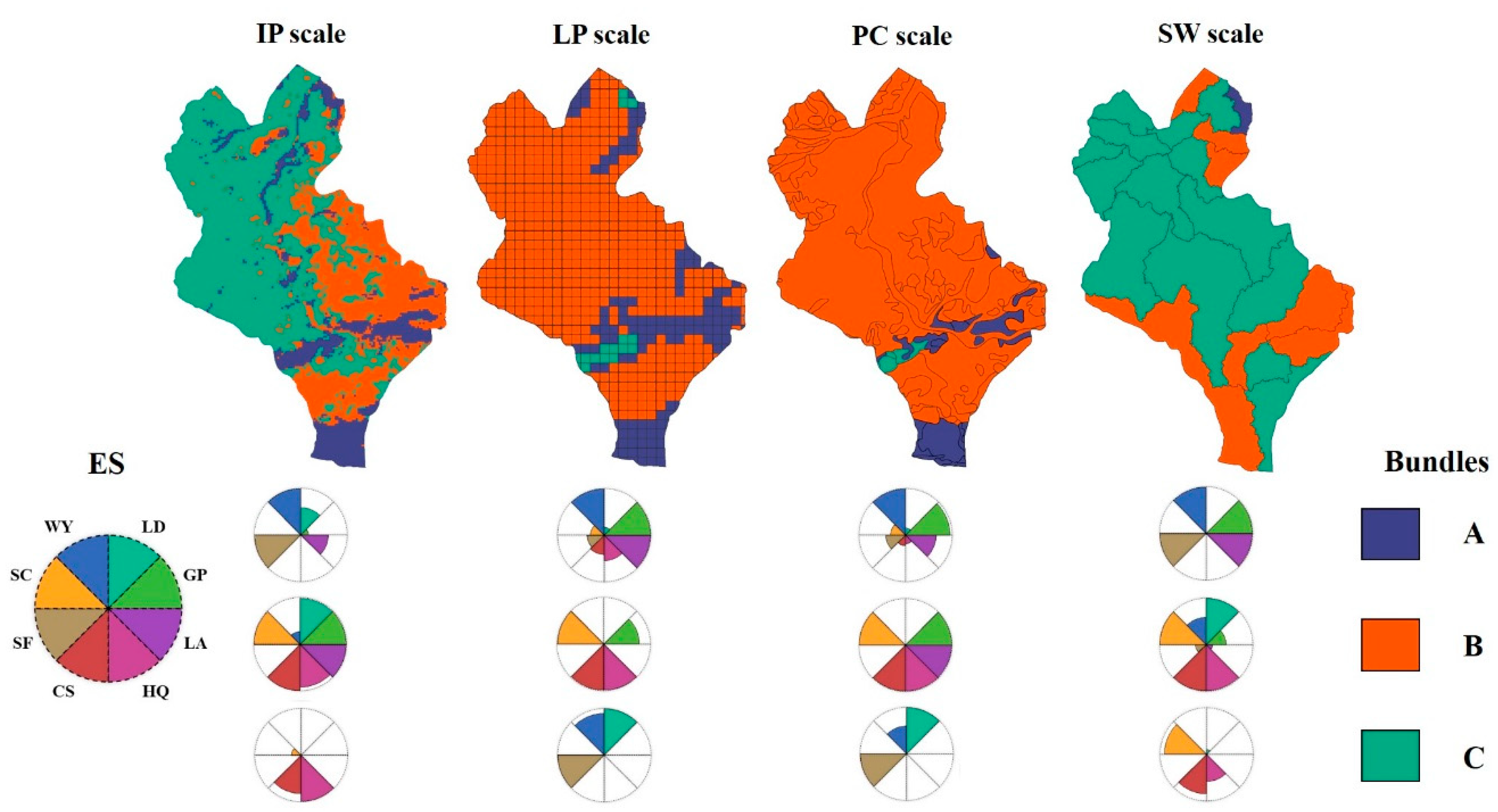
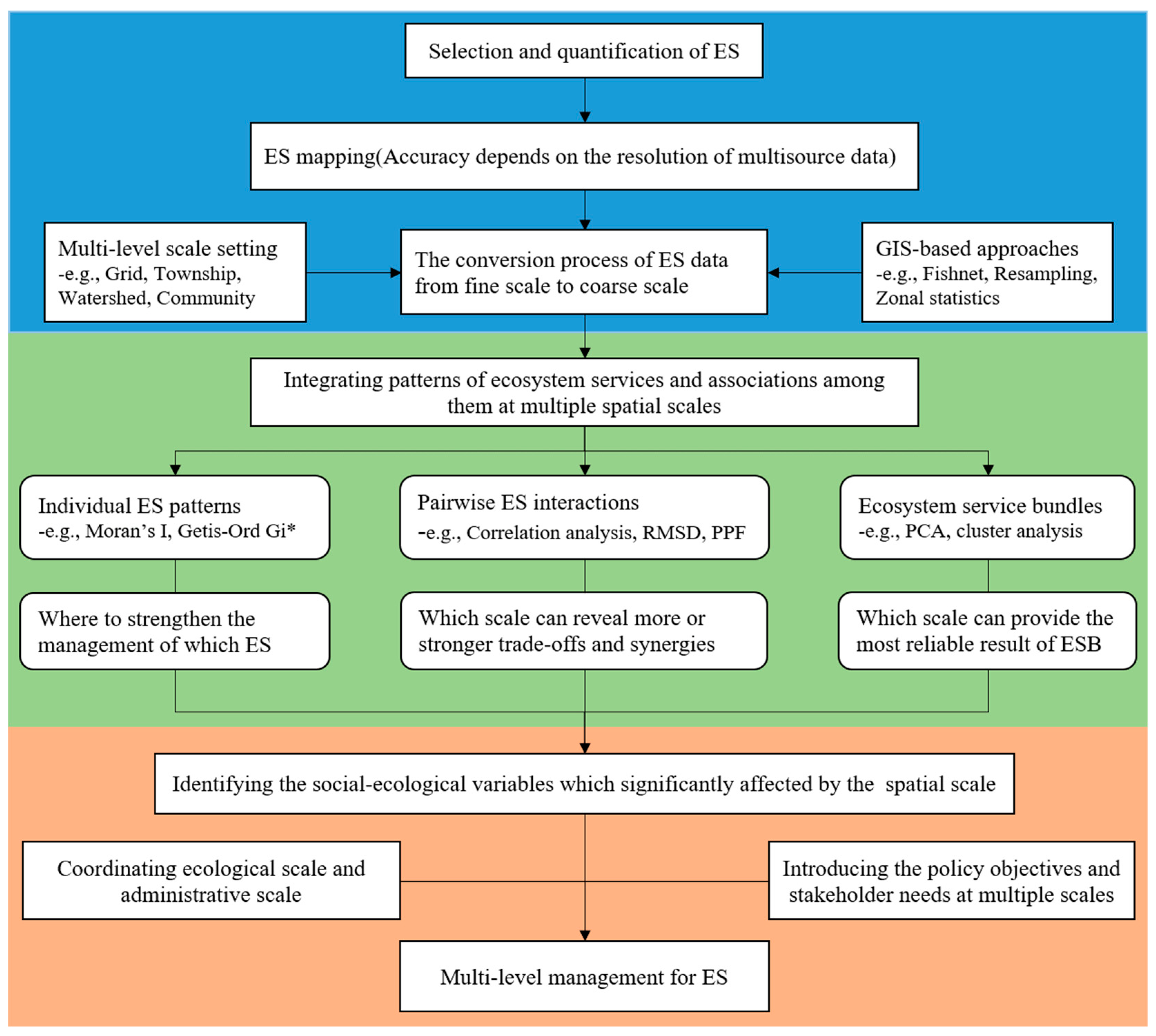
| Service Category | ES Assessment | Code | Unit | Description | Quantizing Method |
|---|---|---|---|---|---|
| Provisioning | Grass Production | GP | Kg/ha | Estimated weight of dry grass yields after the dehydration of fresh plants. | Remote sensing model for hay yield |
| Livestock Density | LD | Tlu/ha | Estimated number of livestock raised per pixel based on climate, environment, population or terrain factors. | Statistical modelling of livestock distribution | |
| Water Yield | WY | mm | Estimated water yield per pixel based on hydrological processes, such as precipitation and evapotranspiration. | Water yield module of InVEST | |
| Regulating | Soil Conservation | SC | t/ha | Amount of sediments that vegetation preserved under water erosion during rainfall events. | Revised Universal Soil Loss Equation (RUSLE) |
| Sand Fixation | SF | t/ha | Amount of sediments that vegetation fixed under the condition of wind erosion. | Revised Wind Erosion Equation (RWEQ) | |
| Carbon Storage | CS | MgC/ha | Amount of carbon that is sequestered from plants and soil. | Carbon storage module of InVEST | |
| Maintenance | Habitat Quality | HQ | Probability | Ability of the ecosystem to provide conditions appropriate for individual and population persistence. | Habitat quality module of InVEST |
| Cultural | Landscape Aesthetics | LA | Scores | Potential visual appeal is controlled by inherent landscape characteristics, such as topography or vegetation. | Visual Quality Index (VQI) |
| Data | Description | Source |
|---|---|---|
| Basic information | Administrative boundaries, administrative center, roads, and rivers in the study area | National Basic Geographic Information Center (http://ngcc.sbsm.gov.cn/) |
| Land use/cover | Land use data generated by interpretation of Landsat TM remote sensing images from 2010 at 30 m spatial resolution | Data Center for Resources and Environmental Sciences, Chinese Academy of Sciences (http://www.resdc.cn/) |
| NDVI | MOD13Q1, Normalized Difference Vegetation Index (NDVI) grid data at 250 m spatial resolution | NASA-MODIS (https://modis.gsfc.nasa.gov/data/) |
| DEM | Shuttle Radar Topography Mission (SRTM) Digital Elevation Model (DEM) at 90 m spatial resolution | CGIAR-CSI (http://srtm.csi.cgiar.org/) |
| Livestock density | Spatial distribution of cattle and sheep density in 2010 at 1000 m spatial resolution | FAO-Geonetwork (http://www.fao.org/) |
| Soil data | Version 1.2 of the Harmonized World Soil Database (HWSD) at 1000 m spatial resolution: Soil texture, soil particle size, and organic carbon content of topsoil | Cold and Arid Regions Science Data Center at Lanzhou (http://westdc.westgis.ac.cn/data/) |
| Vegetation data | Vector data from the Chinese Vegetation Atlas containing the spatial distribution of vegetation types and communities in China at a scale of 1:1,000,000 | Cold and Arid Regions Science Data Center at Lanzhou (http://westdc.westgis.ac.cn/data/) |
| Climate data | Temperature and precipitation data from 13 meteorological stations within the study area, as interpolated by ANUSPLIN at 30 m spatial resolution | China Meteorological Sharing Service System (http://data.cma.cn/data/) |
© 2018 by the authors. Licensee MDPI, Basel, Switzerland. This article is an open access article distributed under the terms and conditions of the Creative Commons Attribution (CC BY) license (http://creativecommons.org/licenses/by/4.0/).
Share and Cite
Dou, H.; Li, X.; Li, S.; Dang, D. How to Detect Scale Effect of Ecosystem Services Supply? A Comprehensive Insight from Xilinhot in Inner Mongolia, China. Sustainability 2018, 10, 3654. https://doi.org/10.3390/su10103654
Dou H, Li X, Li S, Dang D. How to Detect Scale Effect of Ecosystem Services Supply? A Comprehensive Insight from Xilinhot in Inner Mongolia, China. Sustainability. 2018; 10(10):3654. https://doi.org/10.3390/su10103654
Chicago/Turabian StyleDou, Huashun, Xiaobing Li, Shengkun Li, and Dongliang Dang. 2018. "How to Detect Scale Effect of Ecosystem Services Supply? A Comprehensive Insight from Xilinhot in Inner Mongolia, China" Sustainability 10, no. 10: 3654. https://doi.org/10.3390/su10103654
APA StyleDou, H., Li, X., Li, S., & Dang, D. (2018). How to Detect Scale Effect of Ecosystem Services Supply? A Comprehensive Insight from Xilinhot in Inner Mongolia, China. Sustainability, 10(10), 3654. https://doi.org/10.3390/su10103654





